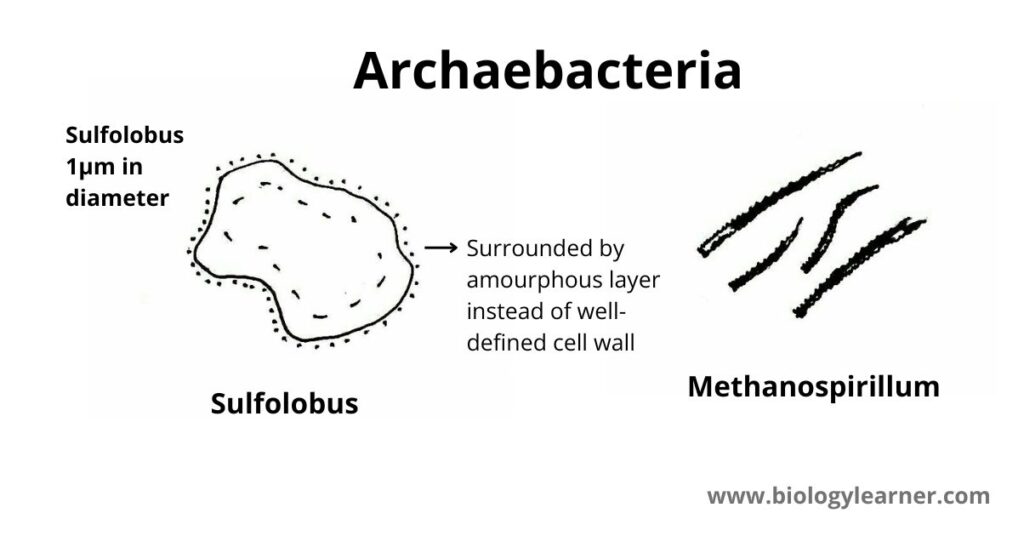Kingdom monera are divided into two major groups. One is Archaebacteria and the other one is Eubacteria.
Archaebacteria are ancient and most primitive forms of bacteria living in extreme environments. They appear to be the oldest of the living fossils.
Definition of Archaebacteria
Archaebacteria are an ancient and primitive group of bacteria living in extreme environmental conditions.

Characteristics of Archaebacteria
The important characters of Archaebacteria are:
- They can live in extreme environmental conditions like extreme saline conditions, and extremely acidic and hot temperatures (110°C).
- They are mainly unicellular or mycelial.
- Peptidoglycan is not present in the cell wall and is made up of protein and non-cellulosic polysaccharides. In some methanogens, Pseudomurein occurs.
- The cell membrane is a monolayer of branched-chain lipids. The fatty acids are attached to glycerol by ether bonds(-O-CH2-) instead of ester bonds (-O-CO-).
- The amount of guanine and cytosine in DNA is 21-68 moles%.
- They have a covalently linked closed circular genome.
- Ribonucleotides of 16S rRNA are different from other organisms.
- Nutritionally, they range from chemolithoautotrophs to organotrophs
Examples of Archaebacteria
Some common Archaebacteria are Sulfolobus, Thermoplasma, Halobacterium, Methanococcus, Methanospirillum, etc.
Similarities with eubacteria
- Lack of membrane-bound cell organelles.
- Ribosome 70S type
- Nucleic acid is not bounded by the nuclear membrane.
Similarities with eukaryotes
- Peptidoglycan is absent in the cell wall.
- Genes occasionally have introns.
- Mechanism of protein synthesis.
Classification of Archaebacteria
Based on metabolic activities and living conditions, Archaebacteria are divided into three major groups.
- Methanogens
- Halophiles
- Thermoacidophile
Methanogens
Methanogens are stringent obligate anaerobic bacteria producing methane(CH4) from carbon dioxide or formic acid.
Characters of Methanogens
- They are stringent obligate anaerobic and autotrophs.
- Methanogens are using hydrogen and carbon dioxide as substrates for energy sources.
- They produce methane from carbon dioxide. They are, therefore, called methanogens.
- The main component of the cell wall is psudomurein. Methanogens are widely used in sewage treatment processes.
- Examples: Methanobacterium, Methanococcus, Methanospirillum, etc. are examples of methanogens.
Halophiles
Halophiles are aerobic achemoheterotroph archaebacteria thriving in extremely strong brine i.e. salt solutions, by using light energy to carry their metabolic machinery by the production of ATP ( Adenosine triphosphate).
Characters of Halophiles
- They are aerobic and chemoheterotroph in nature.
- They have used amino acids as the source of carbon and energy.
- Halophiles live in extremely salt solutions (like the dead sea, great salt lake). They are, therefore, known as halophiles.
- The main component of the cell wall is the large acidic glycoprotein.
- They can absorb solar radiation and the absorbed light is utilized in the synthesis of ATP.
- Examples: Halobacterium, Halococcus.
Thermoacidophiles
Thermoacidophiles can tolerate high temperature as well as high acidity and can reduce sulfur to hydrogen sulfide under anaerobic conditions.
Characters of Thermoacidophiles
- They are aerobic or anaerobic and chemoheterotroph or chemoautotroph type of bacteria.
- They grow in high temperatures and acidic conditions.
- Either cell wall is present(Sulfolobus) or not present (Thermoplasma).
- Examples: Sulfolobus, Desulfurococcus, Thermoproteus, etc.
